A Euro-style area control game where you are a wealthy family in Renaissance-era Florence trying to gain favor with the nobility
1-5 Players
40-80 minutes
Designer: Dean Morris
Artist: Dan May
Publisher: Braincrack Games
The third game in Braincrack’s Eurocity trilogy is here! Florence is the final installment in a series of games themed around cities in Europe. Last fall we reviewed Ragusa, more recently we enjoyed Venice, and now it’s time for Florence!
While each game in the series has theme and artwork in common, the mechanisms are distinct. Florence is tough to classify into one category, because game play is truly unique. It’s a twist on an area control game where the best areas are constantly changing and players must weigh choices between short- and long-game strategy. In this review, we’ll provide a gameplay overview, our takes, and our usual parent perspective so you can decide if you should back Florence.
Florence launched on Kickstarter April 21, 2021. To find out more, visit the Kickstarter page HERE.
Note: We played an online version of Florence prior to the Kickstarter launch. The final game may have minor changes to artwork or pieces. Pictures included in this review are of the digital version.

Gameplay Overview
This is a general overview to provide context for the review, not an in-depth how to play. Some rules are glossed over or missing.
In Florence, you play as a family seeking to gain influence in the titular city by wooing the Medici, or the nobility. You will send family members of varying ranks to seek out the Medici as they travel the city in their fancy carriages, bestowing gifts on them for favors and then bragging about all you’ve accomplished.
Pro Tip: Throughout the game you’ll gain points from being in the right place at the right time, so finding that perfect balance of planning ahead and remaining flexible is going to be important for success.
Game Flow
The game is played over 9 rounds, each of which has a variable number of turns and is structured like this:
- Gain Time – this is the game currency. Every action will cost time
- Perform Actions – players take turns in turn order until all players have passed
- Noble (Medici) Movement – one noble per round moves around the board toward their destination marker, giving out points and scandal cards at each location as they pass
- Queue Scoring – each noble scores the queue (or line for our fellow American readers) differently, more on that later
- Cleanup
Pacing will depend somewhat on the variable setup, which we’ll get into below.
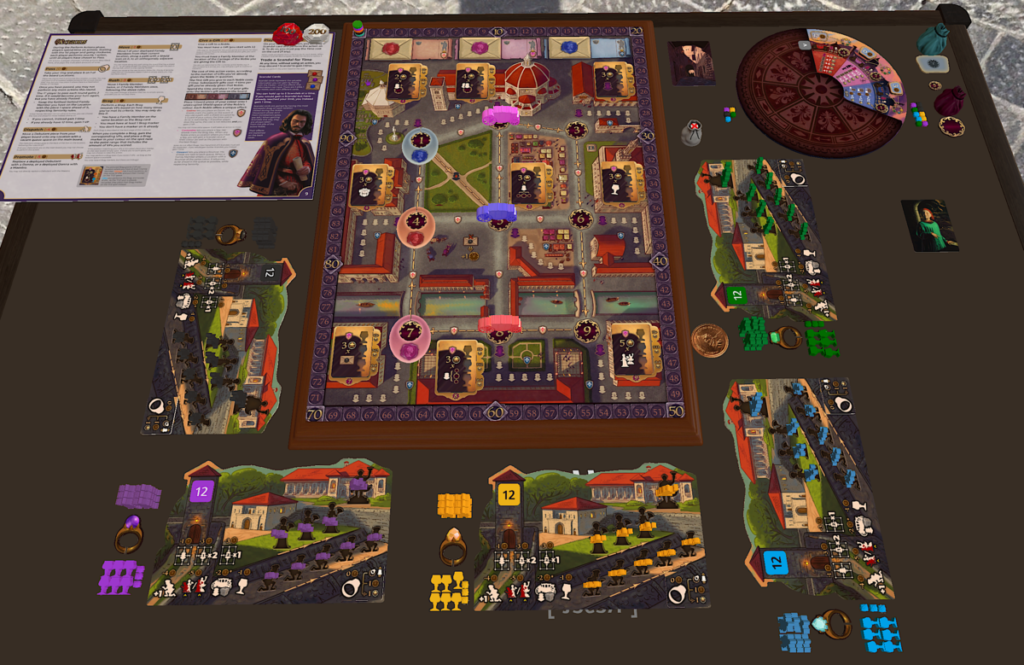
Setup
The game comes with a central board, player mats, and various pieces in player colors. We’ll highlight below the main parts of setup that show how much variability there will be from game to game.
Selected set up:
- Brag tiles: distribute brag tiles to each area on the board in a random order
- Noble Carriages: draw a location token for each noble and place the carriage in that location on the board
- Give each player a goal card
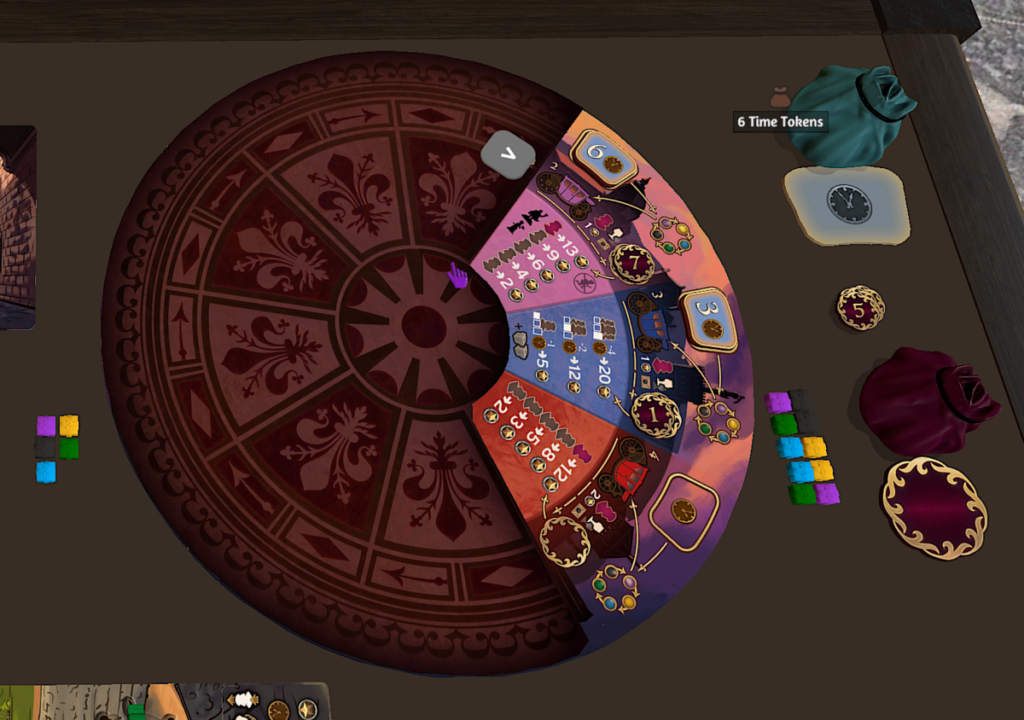
- Dial:
- Set up so rounds 1-3 are visible. Each round will end with a single noble moving around the board toward their destination marker. You know which noble it is by the background color of the round on the dial.
- Round 1 always starts with 12 time, but draw time tokens and place on rounds 2 and 3. This will determine how much time you gain in the beginning of those rounds
- Draw 3 more location tokens and place one on each of the three visible rounds. Place the destination markers for each noble on the central board in the corresponding locations
- First placement: in player order, place one debutant on the board for free
Concept: Status (Rules of Society)
Your family is made up of three ranks: 5 Debutantti, 3 Donne, and 1 Maestro.
Throughout the game, you’ll be lining up against other players at each location (the queue), with the ranking meeple always taking the lead. In general, the first meeple to an area takes the leading position. Subsequent meeples of the same rank (ex. the second Debutant to arrive) line up behind the first. Higher-ranking meeples cut in line (ex. Donna goes in front of a Debutant).
Pro Tip: You won’t be able to cut in line above a higher-ranked meeple, but there are ways to get ahead of other same-ranked meeples using gifts and cards. These can be a huge advantage when it comes to scoring.
Concept: Time
How do you pay for things? The nobility have all the money and trinkets they really need, what they truly want is your time.
Throughout Florence, you’ll pay for each action with time. At the beginning of each round, you’ll gain a certain amount of time to use. You may also carry over time from previous rounds or you can exchange cards from your hand for +1 time.
Pro Tip: Time is precious. Pay attention to upcoming rounds and how much you’re going to get – it might make way more sense to pass and save some up to do more later.
Actions
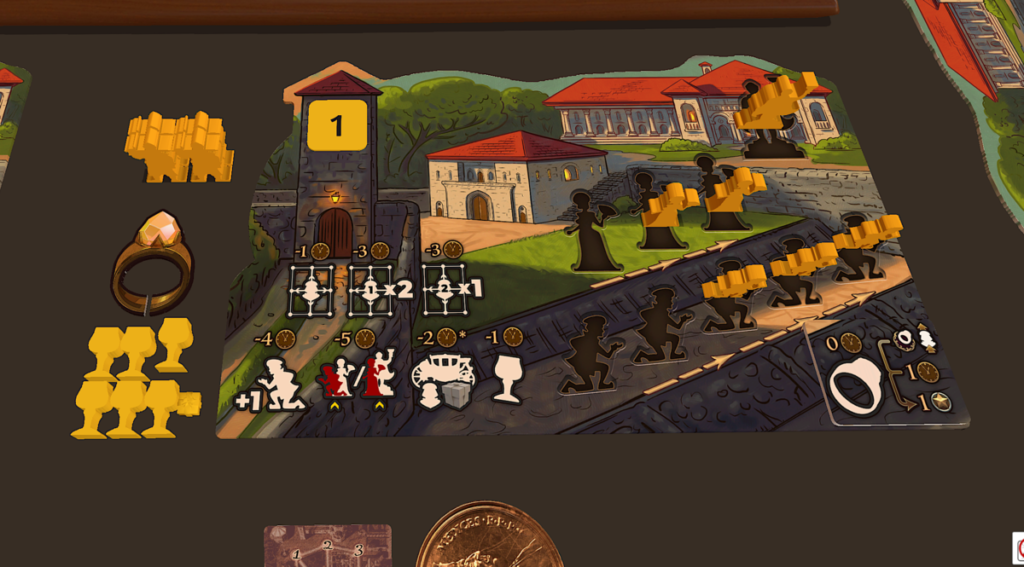
- Movement Actions: You can move
- One meeple one space for -1 time
- OR one meeple two spaces for -3 time
- OR two meeples one space each for -3 time
- Dispatch: Move a debutant from your player mat to anywhere on the board, following the Rules of Society for how they line up (queue). You can only dispatch a debutant, not a Donna or the Maestro
- Promote: Switch your debutant for a Donna, or one of your Donne for your Maestro for -5 time
- Give a gift: if you have a meeple at the same location as a noble’s carriage, you can give them a gift for -2 time (add -1 time for every gift you’ve already given that noble)
- Cosimo (Red): place a guard on a path on the central board. Every time you move past that guard, pay one less time
- Contessina (Pink): place a guard meeple on a brag tile to serve as your spy. Every time a noble passes that location, gain +1 scandal card
- Giovanni (Blue): place a guard meeple on a building as a bouncer, your family members now move to the front of the line (queue) at that building, still obeying the ranking rules of society (debutant can’t pass a donna)
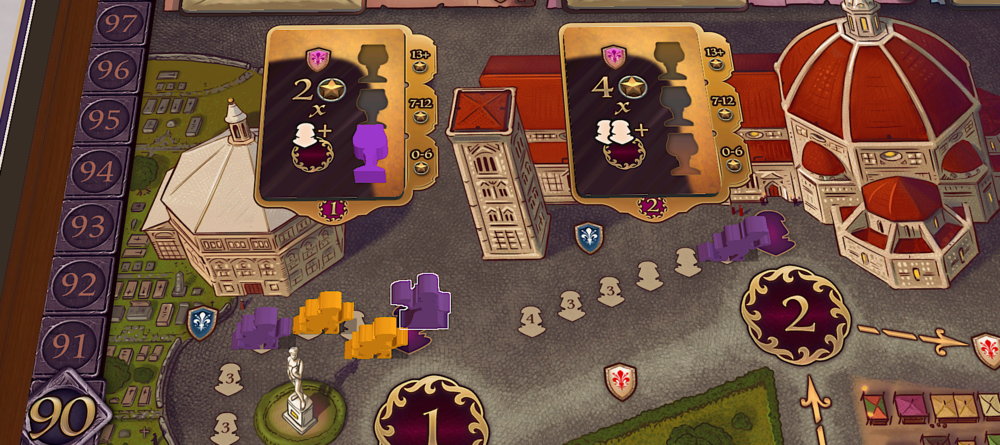
- Brag: for -1 time, you may place a brag token on one of the brag cards where you have a family member present.
Pro Tip: Bragging is one of the best ways to earn a ton of points, and the highest brag token on a brag tile gets a scandal card from each noble that passes that location throughout the game. Balance putting out a few brag tokens early (fewer points, but more cards) with putting more out late game (fewer cards, more points).
- Play a Scandal Card: you can play a card from your hand and resolve its effects as your turn. Often scandal cards let you do a normal action for less time (lower cost), but some are super cool
- Pass: place your ring token on a space. For each time the round continues and skips you after you’ve passed, you get bonuses:
- 1st skipped turn: Move a family member up the queue (if possible) at the location of your ring token
- 2nd skipped turn: +1 time
- 3rd skipped turn and on: +1 point
Noble Movements
Once every player has passed, it’s time for the noble to move. Only one noble moves each round, indicated by the background color on the dial. Move the noble’s carriage along the path, following the arrows. At each location, stop and give the first player in line the indicated points for that round on the dial. Also draw cards for the highest brag token and for the player who has a guard (Contessina’s spy) on that brag tile.
End the noble’s movement at the destination marker.
Score the Queue
Players earn points each round based on the number and position of family members in the line (queue) at the location where the noble movement ends. Each noble scores the queue differently:
- Cosimo: grants points based only on position in the line
- Contessina: grants points only to Donne and Maetros, she doesn’t waste her time with debutants
- Giovanni: awards based on number of family members a player has at that location. Rank/order only matter for tiebreakers. Players must also spend time to gain his trust – scoring the points costs time, so don’t forget to save some. If you can’t pay time, you can’t take the points!
Clean Up
After the noble movement, get ready for the next round:
- Turn the dial, revealing a new round
- Add a time token and a destination marker location token. Move the noble’s destination marker
- Take time
- Rounds 3 & 6 players get extra gift tokens they can use
- Move 1st player marker clockwise to the next player
Game End
The game ends after the queue scoring in the 9th round. Players score 2 time = 1 point, and may also score their goal card.
What do we think?
We honestly loved this game. There’s a ton going on and a million “good” decisions you can make in any given turn, any of which could be the “best” decision depending on your plan. You have to play both the short and the long game, and you have to be very reactive and flexible based on what other players are doing.
We played at both 4-player and 2-player and we liked both player counts. They do have different feels, though. The 4-player game is a lot more interactive and compact. You have fewer choices, but that adds an element of urgency that’s super fun to plan around and constantly react to. The 2-player games still had tension and interaction, but far less than the 4-player game. We actually didn’t mind that 2-player was less restrictive because it lets us have more freedom to enact huge plans.
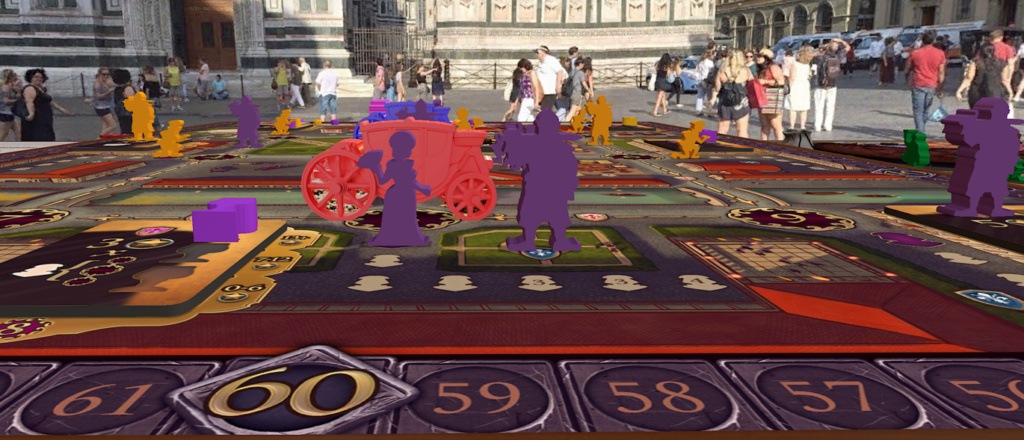
What did we like?
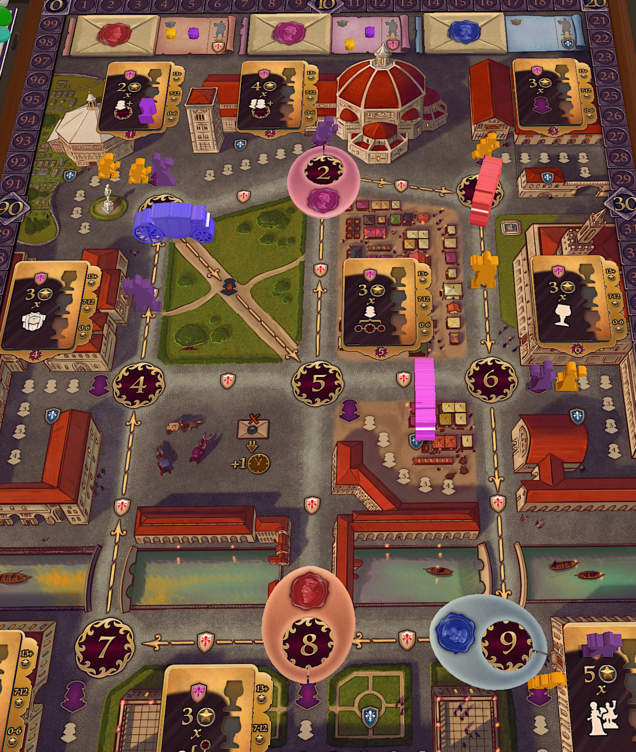
There’s a ton we liked about this game. That it plays really well at different player counts is a bonus – we’d be just as happy to break this out with just the two of us as we would with our game group.
We also love games that have “many paths to victory”, meaning two players can focus on completely different strategies and still end up neck and neck in the score. That’s a sign of a well-balanced game and a game that we want to keep playing so we can try different things. Having so many parts in the setup vary from game to game helps with that a lot too.
Florence is also a really interesting take on an area control/area majority game. The area you want to control each round changes, which is a super interesting twist that’s fun to try and plan for.
For example, do you know you aren’t going to have time left over to pay for the points at the end of a Giovanni (blue) round? Then plan for the next round by moving your meeples to the queue at the destination for Cosimo (red) and get all those points, blocking your opponents in the process.
What didn't we like?
We enjoyed this game at 2-player, but it might not be for everyone. At lower player counts, you have fewer spaces available in the queue, but the same number of total locations on the board. Because of this, you do lose some of the tension that comes from fighting for the right position in a queue, since there are just fewer pieces total on the board and just limiting the number of spots doesn’t entirely solve the problem.
For us, it’s not a huge deal. There is still a bit of a “rush” by both players to get at least one meeple on the noble’s path and especially into the correct queue to score at the end of each round. We actually like it, since this means you’re more likely to be able to enact big, grand strategies and there is still enough tension to keep it interesting, but some might prefer the tighter gameplay at higher player counts.
Who will like this game?
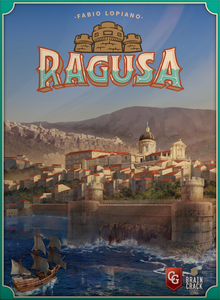
This is the third game in a series, and while they are all distinct they definitely play off one another in more than theme. Each has an element of player interaction and tight gameplay. We’ve also found that all three are relatively successful at creating an interactive Euro style game that plays well at 2 player – not an easy feat!
Anyone who likes Euro style games will find something to love about Florence. It’s on the heavier side of medium weight, so is a better fit for experienced gamers or newer gamers wanting to really stretch their wings.
While not exactly the same, Florence does remind us of our other favorite game that has a unique take on area control – Ginkgopolis. Fans of that brain buster will probably enjoy Florence as well.
Sarah's Take
Florence is a type of game that I am learning that I really like, essentially a hodgepodge of bits and pieces of common mechanisms.
Now, I am bad at Florence. Like, lose by 30-40 points bad. But it’s still fun. Late turns in the game can have you getting 25-30 points on a turn if you play it right so don’t judge me too hard. In a two player game there is a lot of “well if I do this action I will get me 15 points but that opens the door for Emily to get 11 points but this other action will get me 11 points but limits her”. I love that type of decision making. Emily and I are fiercely competitive and will often do whatever we can to make sure the other doesn’t get a bunch of points.
I also really enjoy the interaction in this game, when oddly enough, there is no direct interaction. Florence really relies on you knowing what your opponent is doing, what they have available to them, and what they might be thinking. It’s a truly great game for us to play as a couple because we can get into each other’s heads. Gah, just writing this review makes me want to go play Florence!
Emily's Take
I really, really love that I can plan pretty far ahead in this game, but I also love that there are twists and turns throughout that force me to adapt as well. Even at 2-players, which is comparatively chill, I have to focus on what Sarah is doing at all times or I could miss something important.
I also like that the rules are relatively straightforward, but gameplay can be really complex. There’s a lot of nuance and a lot of choices that make each game interesting. There are a lot of “HA!” moments when one of us takes a spot or does something particularly clever that makes the time fly.
The re-playability is also spot on. Even if there wasn’t so much variability in the set up, the nature of the decisions means there’s a lot of strategies to try. So far I’ve found a couple that seem to work, but the best thing is to make sure you’re reacting to the other players and not getting caught up in your own world.
Breakdown
Rulebook / Learning the game
We had the opportunity to learn Florence from designer Dean Morris. For the breadth of decisions in Florence, the rulebook is very straightforward and succinct. We had no trouble going looking back through the rules to reference things as needed. One thing to note is that we did not find ourselves needing to go revisit the rulebook very often, since the iconography is pretty good and the rules surprisingly straightforward for the weight of the game.
First Play
As we mentioned previously, our first play of Florence was taught by Dean Morris and played with two other content creators. Everyone at the table picked up on the game pretty quickly and we all picked up on the different strategies available. We managed the teach and the first playthrough in just under 2 hours.
One of our gripes with Venice is that the iconography was not intuitive and times often added its own element of confusion to the game. We are thrilled to report that this is not the case in Florence. The iconography in Florence is clear, intuitive, and very easy to remember once you learn it.
Subsequent Plays
All of our subsequent plays were at 2 players. While we do think that the sweet spot for a highly interactive game of Florence is likely at 3-4 players, it still works wonderfully for 2 players. We had a series of nights where we each only wanted to play Florence and try out new strategies (sadly, this still did not get Sarah a single win). Time really flies when you’re playing Florence (ah, see what I did there??).
Parent Perspective
Interruptions
As usual, we had our fair share of interruptions during our plays of Florence. Florence relies heavily on being aware of what the players around you are doing which can make interruptions difficult. It is not so much that the game is directly interactive but rather that it is critical to know what your opponent did so that you can plan your turn. You will absolutely get burned in Florence if you are not paying attention to your surroundings.
Time Investment
Once we became more familiar with the rules and the breadth of the decision making space in Florence a two player game took us about 50-60 minutes to play on Tabletop Simulator (TTS).
Life Fit
Florence is short enough to be a school night game, but it’s best to play when you’re not as likely to get interrupted. For us, it’s the perfect game for when Nana takes the kids for a few hours.
Rating
8/10
Florence is an exciting game that works wonderfully at all player counts. It provides great tension and interaction without directly attacking your friends or spouse. There are many unique paths to victory allowing for multiple strategies and gameplay experiences during each play. Florence will be an eagerly anticipated addition to our game library.
*See our rating scale HERE
To learn more, visit the Kickstarter page HERE.
Click through for more posts, or follow us on social media to see what we’re playing and for new post updates!
